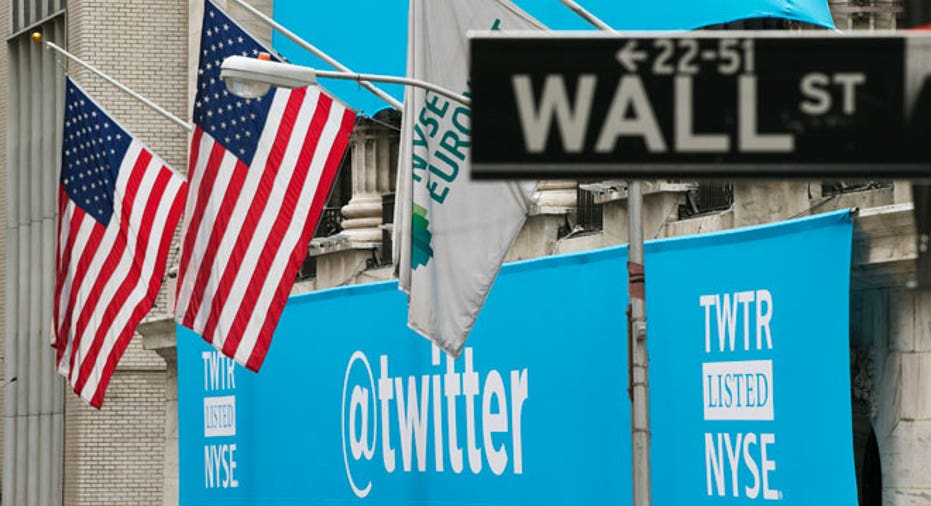Should Silicon Valley Be Toasting Twitter IPO?

As Twitter makes its public debut on the New York Stock Exchange Thursday with a valuation of $14.1 billion, some have whispered about the potential for a second dotcom bubble.
While the microblogging platform has 230 million users internationally, Twitter lost $65 million last quarter, and its path to achieving profitability is anything but certain.
“A lot of companies like Twitter haven’t turned profitable yet before they go public, wanting to get bigger and then worrying about [profitability],” says James Gelfer, an analyst with VC and private equity research firm PitchBook Data.
Looking at companies like Snapchat and Instagram (the former is valued to be worth more than $3.5 billion and the latter was acquired by Facebook for $1 billion), Gelfer says there is concern that there are “bubble-like tendencies” popping up regarding digitally-sexy companies that aren’t yet profitable. Some high-profile startups have been raising a number of major rounds in rapid succession; Pinterest raised $200 million in February and $225 million last month, pegging the company’s valuation at $3.8 billion.
“There seems to be early indications of a bubble,” says Gelfer. “Some of the valuations, at least from our end, seem to be quite high.”
Some analysts, however, say it’s not time to rain on the Twitter parade.
“Twitter has quite a beachhead in microblogging,” says Kathy Smith, an expert with IPO investment manager Renaissance Capital. She says the platform’s solid footing in the face of social media competitors sets it apart from other startups, whose high valuations might raise more of an eyebrow.
Lightspeed Ventures partner Bipul Sinha also brushes off concerns regarding Twitter’s profitability.
“Lack of profitability could stem from reinvestment,” says Sinha, who says that companies that are actively reinvesting in their future should get a pass on this front. For Sinha, the key indicators are the size of the user base and engagement on the platform – which he says are major strengths for Twitter.
“Early advertisements have proven to be scaleable, the platform is keeping the user engaged and users are coming back over and over again,” says Sinha. “I think profitability will come.”
Lessons Learned from 1999?
While Gelfer says there are reasons to be concerned, he says the fact that the alarms of a bubble are even ringing is a good sign.
“I think there’s definitely still people who remember the dotcom era, and the talks about bubbles are coming up earlier than they did back then,” says Gelfer.
While Sinha agrees that some companies are indeed a bit overvalued, he says he’s not seeing “bubble-like excess” in the community.
Looking to RingCentral and Violin Memory – two startups that recently went public on the same day – Sinha says there’s evidence that investors aren’t getting overly excited.
“They went public on the same day and had very different reactions from the public market,” says Sinha.
“That tells me that the public market investors are looking at the business fundamentals … and people are still making rational decisions. Not everyone is getting a massive pop,” he says. RingCentral’s stock rose 40% on its first day of trading, while Violin Memory’s dropped 22%. RingCentral is in the cloud computing space; Violin Memory produces flash memory.
What Do Entrepreneurs Know Now … That They Didn’t Know Then?
Sinha says founders are also smarter than they were during the times of the dotcom bubble that formed in the 1990s.
“Startup entrepreneurs have learned you need business fundamentals to be strong in order to go public,” says Sinha. “You’re not going public with $5 or $10 million revenues – you’re seeing that the top line growth is hitting the $100 million trajectory.”
Matthew O’Loughlin, a Manatt, Phelps & Phillips partner who advises public and private companies, investors and private equity groups, says some of the allure of going public has faded since the dotcom bubble burst.
“The construct of increased stature, reputation and standing – that you finally made it – some of that went away a little bit,” says O’Loughlin. He says entrepreneurs no longer look at IPOs as the be-all and end-all of success.
O’Loughlin says it’s not just the dotcom bubble that has caused the shift in thinking. Looking at Enron’s implosion and the resulting tighter regulatory environment, he says entrepreneurs now recognize that going public isn’t just a matter of whether or not investors are expressing interest.
“You’re now a more developed company before you go into an IPO … It doesn’t always make economic sense to have to deal with the compliance costs and also some of the restrictions when you go public,” says O’Loughlin. In this regard, he says he’s heard some analysts criticize Facebook for becoming less innovative and creative now that the company has to post quarterly earnings and answer to investors.
That said, O’Loughlin says an increasingly hot IPO market may mean that some companies are pushed to go public earlier than they should.
“Market timing is a big issue for IPOs – when it’s hot, you want to do it. It may be pushing them to IPO sometime in the near future, from the vantage point that the market may be completely different [in the near future],” says O’Loughlin.